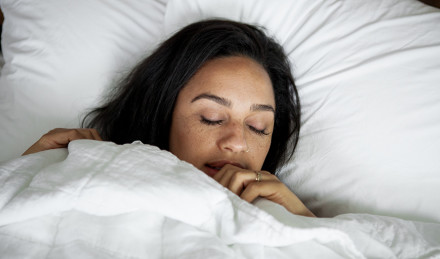From the ancient Greeks to Sigmund Freud, everyone’s got a theory on the origin and function of dreams. But when it comes to the cold, hard facts, the science of dreams is a relatively new area of study. For many years, measuring neurological processes was simply too hard and the subject matter itself was dismissed as too random. But now more studies than ever are popping up, powered by high-tech machinery and an insatiable curiosity to get to the bottom of a long-nagging question: Why do we dream?
R&R: Rest & Rapid Eye Movement
Sleep research’s first major breakthrough happened in 1952, when University of Chicago grad student, Eugene Aserinsky, and his advisor, Nathaniel Kleitman, identified rapid eye movement sleep (aka REM) while observing Eugene’s young son. Typically REM sleep occurs about an hour after we fall asleep and cycles through three to five times during an average night’s sleep, which means about 20% of our total time sleeping – about 2 hours – is devoted to dreaming.
Scientific Skepticism
The activation-synthesis hypothesis introduced in 1977 posits that dreams are the result of physiological processes of the brain. During REM cycles, the limbic system (which manages emotions, sensation and memories) becomes active and the resulting interactions between these seemingly random thoughts and images form distinct cognitive experiences. Basically, our dreams are just a bunch of neurons firing electrical currents at each other. However, this doesn’t mean our dreams are meaningless.
Cognitive Connections
Harvard professor Robert Stickgold began exploring the relationship between waking life and dreams in the late ’90s, famously employing Tetris as a research tool. Yes, Tetris. Robert’s team worked with a group that included expert gamers, novices and amnesiacs. Sixty percent of participants – including three of the five amnesiacs who had to re-learn the game each time they played — reported dreaming about Tetris blocks during early stage sleep. In the novice group, those that reported Tetris dreams improved significantly more than those with block-free dreams.
Sleep On It
More recent studies have explored everything from the relationship between dreams and creativity, learning, emotions and more. Researchers at UC Berkeley found that your mom’s advice to crawl under the covers and sleep off an emotionally charged spat with a friend or lover may hold scientific weight. Subjects were asked to evaluate a series of face photos depicting a range of emotions. Half the group took a medically monitored afternoon nap following evaluation, while the others adhered to their normal nighttime sleep schedule. When participants re-took the face photo evaluation test the next day, the research team found that those who napped – and entered a REM cycle during so — were less reactive to negative emotions such as fear and anger.
Digging Deeper
There are weird dreams and then there are weird dreams. You know what we’re talking about – those eerie, “Inception”–level epics with puzzling twists, mythical creatures and loose rules on gravity and physics. Where do those come from? Scientists are also examining the qualitative features of dreams with the use of cutting edge MRI technology. In 2010, researchers monitored the activity of amygdala and hippocampus in a group of participants who kept detailed dream records over a two-week period. Results found a correlation between activity in these deep limbic system structures and the vividness and bizarreness of specific recorded dreams.

